The Movement to Date and Its Future Prospects
by Brian Hioe
語言:
English
Photo Credit: Brian Hioe
Out of the Death Of One, The Rising Up of Many?
AFTER AN ATTEMPT to occupy the Ministry of Education on July 23rd in which student occupiers got as far as the office of the Minister of Education, since July 30th the Ministry of Education courtyard has been occupied after demonstrators forced down the razor wire barriers and pushed back the police the night of the 30th. The actions of July 30th had been motivated by the suicide of Lin Kuanhua, a student activist who was one of those who participated in the July 23rd action and was arrested during its course.
Since then, the occupiers, mostly high schooler led, have vowed not to leave until their demands are met. Though the present movement of course draws comparison to last year’s Sunflower Movement and before the occupation happened, there had been calls for a “second Sunflower Movement.” Demonstrators speak of “black box textbooks” pushed through by undemocratic, untransparent means just as last year there was talk of the “black box” CSSTA trade agreement pushed through legislature by the KMT without due deliberation. But this time around, there are two concrete demands by occupiers: first that planned textbook revisions be repealed and second that Minister of Education Wu Se-Hwa, who is seen as responsible for Lin’s suicide, resign.
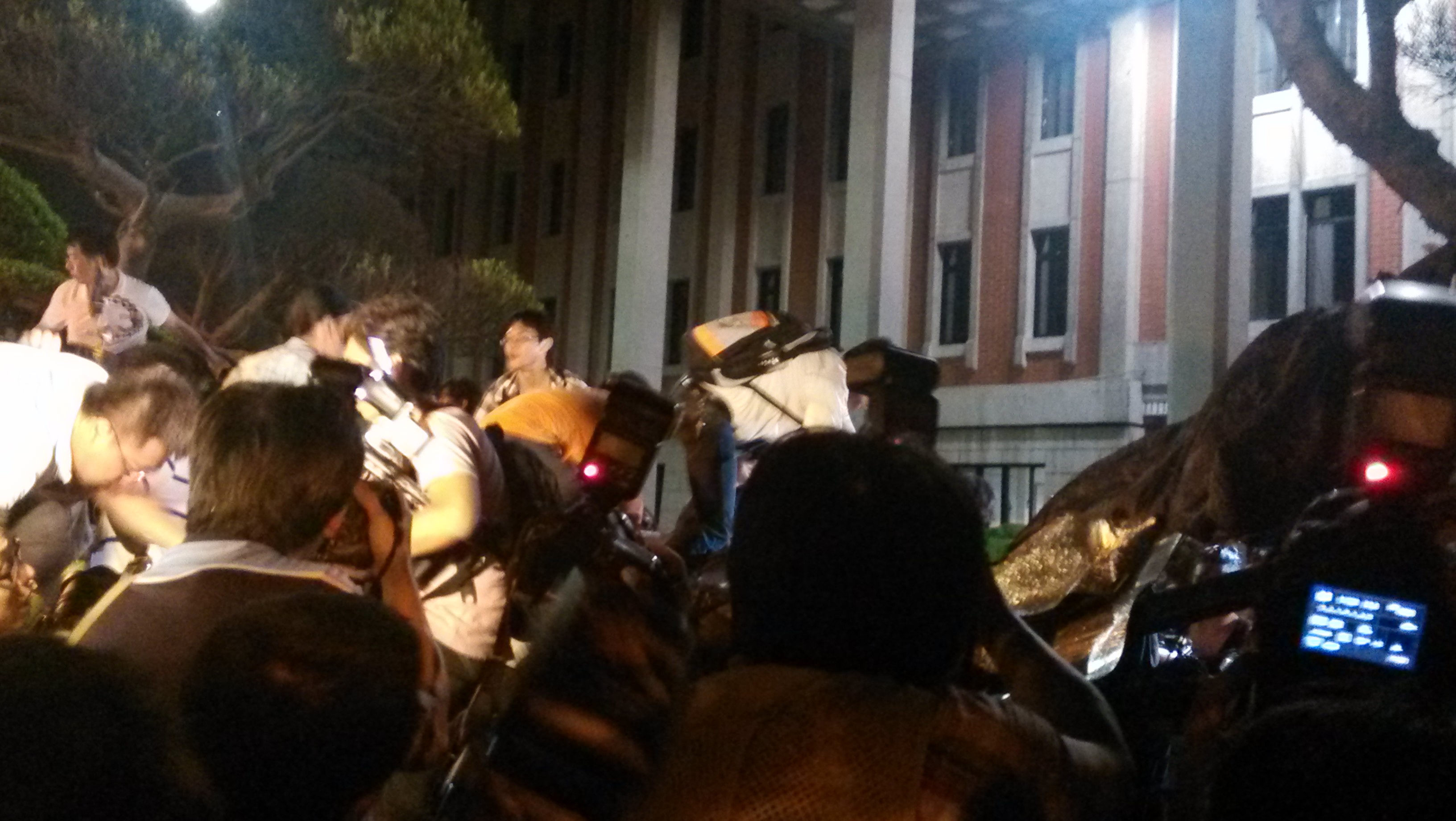 Demonstrators forcing their way over razor wire barriers surrounding the Ministry of Education on the night of July 30th. Photo credit: Brian Hioe
Demonstrators forcing their way over razor wire barriers surrounding the Ministry of Education on the night of July 30th. Photo credit: Brian Hioe
The issue at hand is concerning planned Sinocentric textbook revisions. Planned textbook revisions as pushed for by the KMT would, for example, continue to claim that Taiwan is a part of the “Republic of China” which is the rightful master of mainland China. Textbook revisions would go so far as to claim that the tallest mountains of the Republic of China are the Himalayas and that the capital is in Nanjing, not Taipei.
But if last year’s Sunflower Movement concerned itself with the CSSTA trade agreement and this year with planned textbook revision, is it not that issue still remains fundamentally the same? What is being fought against by Taiwan’s young is the KMT’s claim that Taiwan is China, the KMT’s sole remaining claim to power in Taiwan where the KMT quite often still holds the reins of political power despite the end of overtly authoritarian politics.
Attempts to Discredit the Movement on the Basis of Lin Kuanhua’s Suicide
ALTHOUGH THE issue of textbook revisions in Taiwan had been ongoing for some time in this fashion, the present outbreak of protests was sparked by the suicide of student activist Lin Kuanhua. Lin’s death has itself been some matter of controversy. Lin Kuanhua killed himself by burning charcoal in a closed room on July 30th. Though a variety of factors are no doubt involved in his suicide, Lin’s suicide was aggravated by his frustration to inability to resolve the textbook revision issue and the lack of support of his parents for his participation in political causes. This would echo what Lin’s mother later stated on social media as well as what Lin said in an interview three days before his death.
It may have also been that police persecution after the attempted occupation of the Ministry of Education that took place on July 23rd was another contributing factor to Lin’s suicide. Lin was among those who arrested during the attempt to occupy the Ministry of Education which took place on July 23rd, reportedly the first arrested of those arrested of a group of students who made it as far as Minister of Education Wu Se-Hwa’s office and attempted to barricade themselves within that office.
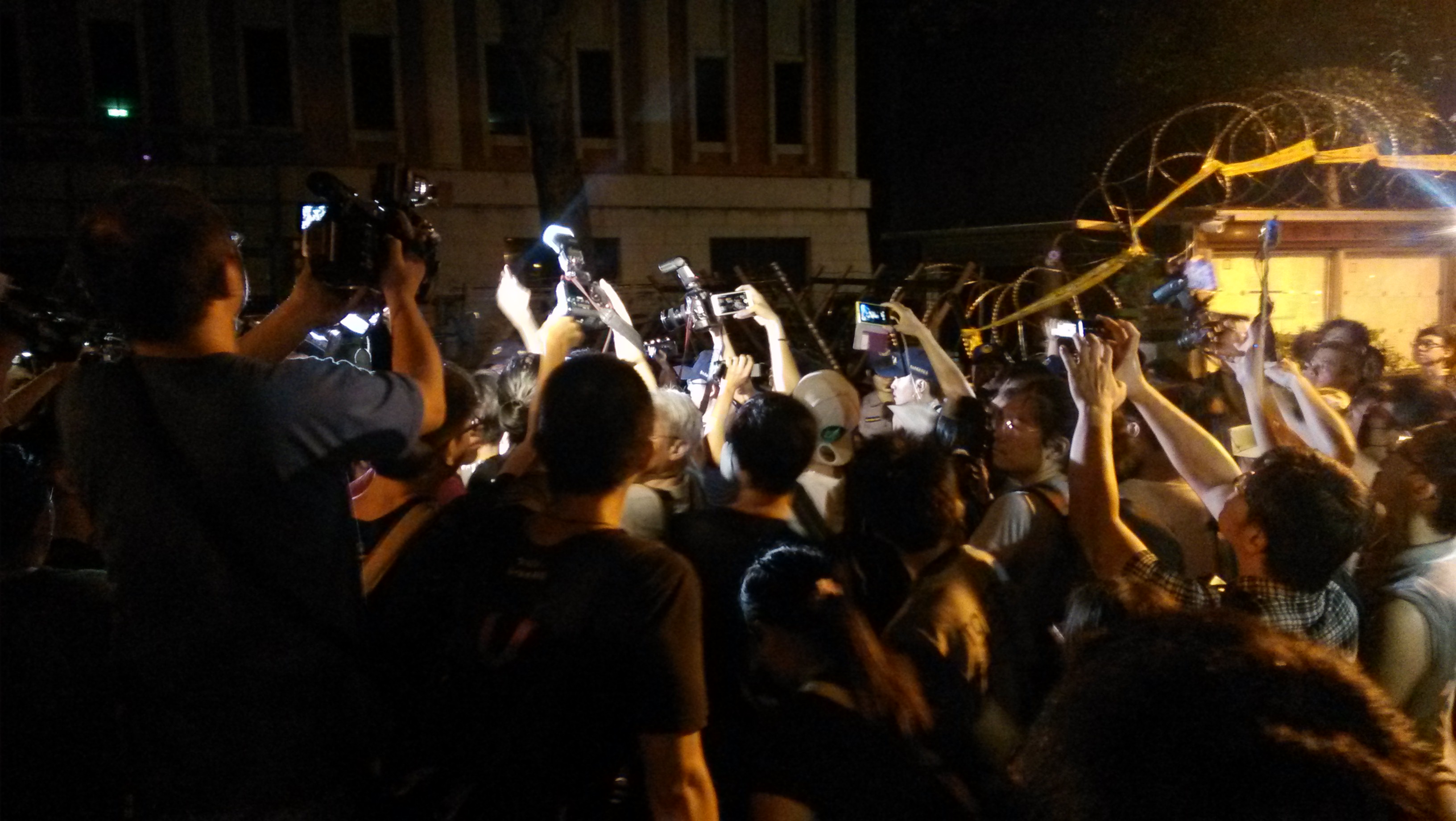 An attempt to force down barricades surrounding the Ministry of Education on the night of July 23rd. Photo credit: Brian Hioe
An attempt to force down barricades surrounding the Ministry of Education on the night of July 23rd. Photo credit: Brian Hioe
Lin has, then, been perceived as the martyr of the movement who sacrificed himself for the cause. Yet Lin’s plans for suicide may have been long-standing, as expressed in a public Line group in which he stated he would undertake an action which would be highly motivating of the anti-textbook revision movement on July 30th.
KMT commentators and others seeking to discredit the movement have, of course, latched onto this fact with various psychologistic attempts have been made to discredit Lin on the basis of for what reason he killed himself or even to question his character. Still others have actually sought to pin the blame onto the DPP, even going so far as to demand that Tsai Ing-Wen should apologize for Lin’s death. But though that we will never know for exactly what reasons Lin took his life, departed as he is, Lin’s death has generally been taken up as the call to action of the movement. And regardless of under what circumstances Lin died or with what rationale in mind, current events are hardly reducible to just that.
Lack of International Coverage or Only Reported on As an Anti-China Issue
IT IS SURPRISING to note that the occupation Taiwan have not, in fact, attracted much international attention. The Ministry of Education occupation in Taiwan is, of course, one of a long string of protests in Asia in the past three months which have gone unreported upon in the international sphere. Because of Taiwan’s international obscurity relative to other Asian countries is concerned on top of that and the means by which it is overshadowed by China, we might not be surprised.
Where the issue of textbook revisions in favor of one political bent or another is often a controversial topic in different countries across the world. Thus, in the past, when Taiwan’s textbook controversy has been reported is through the frame of textbook controversies as they occur globally. This has allowed for some coverage of protests in the past.
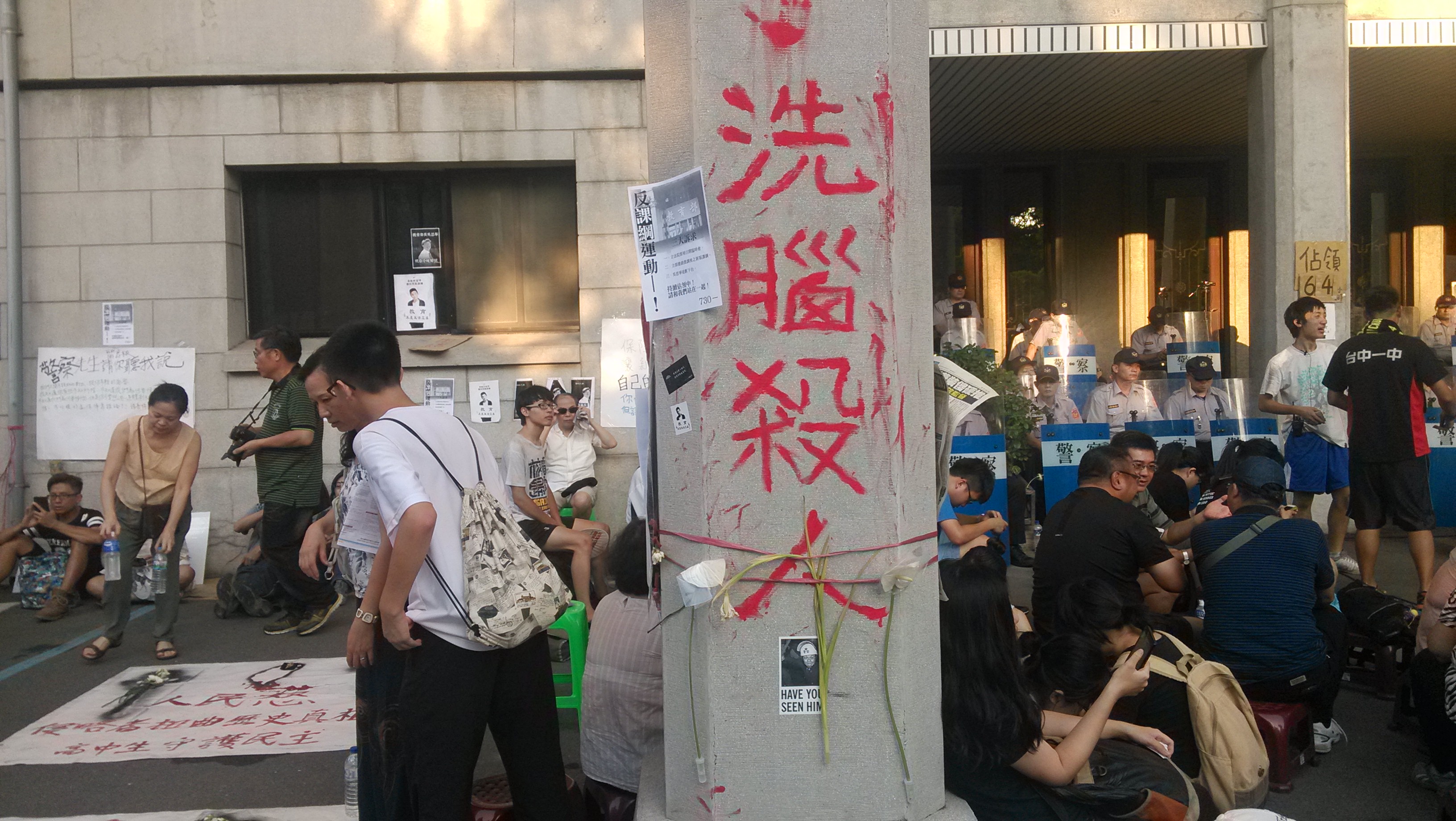 Graffiti on a pillar in the Ministry of Education courtyard. Text reads: “Brainwashing kills.” Photo credit: Brian Hioe
Graffiti on a pillar in the Ministry of Education courtyard. Text reads: “Brainwashing kills.” Photo credit: Brian Hioe
However, all the same, it is not altogether every day that high schoolers whether in Taiwan, Asia, or anywhere protesting textbook revisions are willing to take such drastic actions as we have seen in the present. The only other example would seem to be in Hong Kong, in which Joshua Wong of Umbrella Movement fame originally rose to prominence as leader of Scholarism—a group of secondary students who opposed the China-centric “patriotic education” meant to instill loyalty to China in the generation of Hong Kongers born after the handover of Hong Kong to China.
But here now with the suicide of Lin Kuanhua, the issue has literally become a life and death issue. And still, little mention would be seem to be made of this fact in what international reporting has been written. The tragedy—or even poignantly newsworthy element—of Lin’s suicide would seem to matter little to international media.
Yet if the uniqueness of or the poignant human element of present protests has still failed to capture international attention, it is not surprising then protests have been reported on it is in only regards to the “anti-China” or “Taiwan-China” angle. Of course, if we are to return to Taiwan’s existential dilemma, it is that any news reported on in regards to Taiwan is only in connection to China.
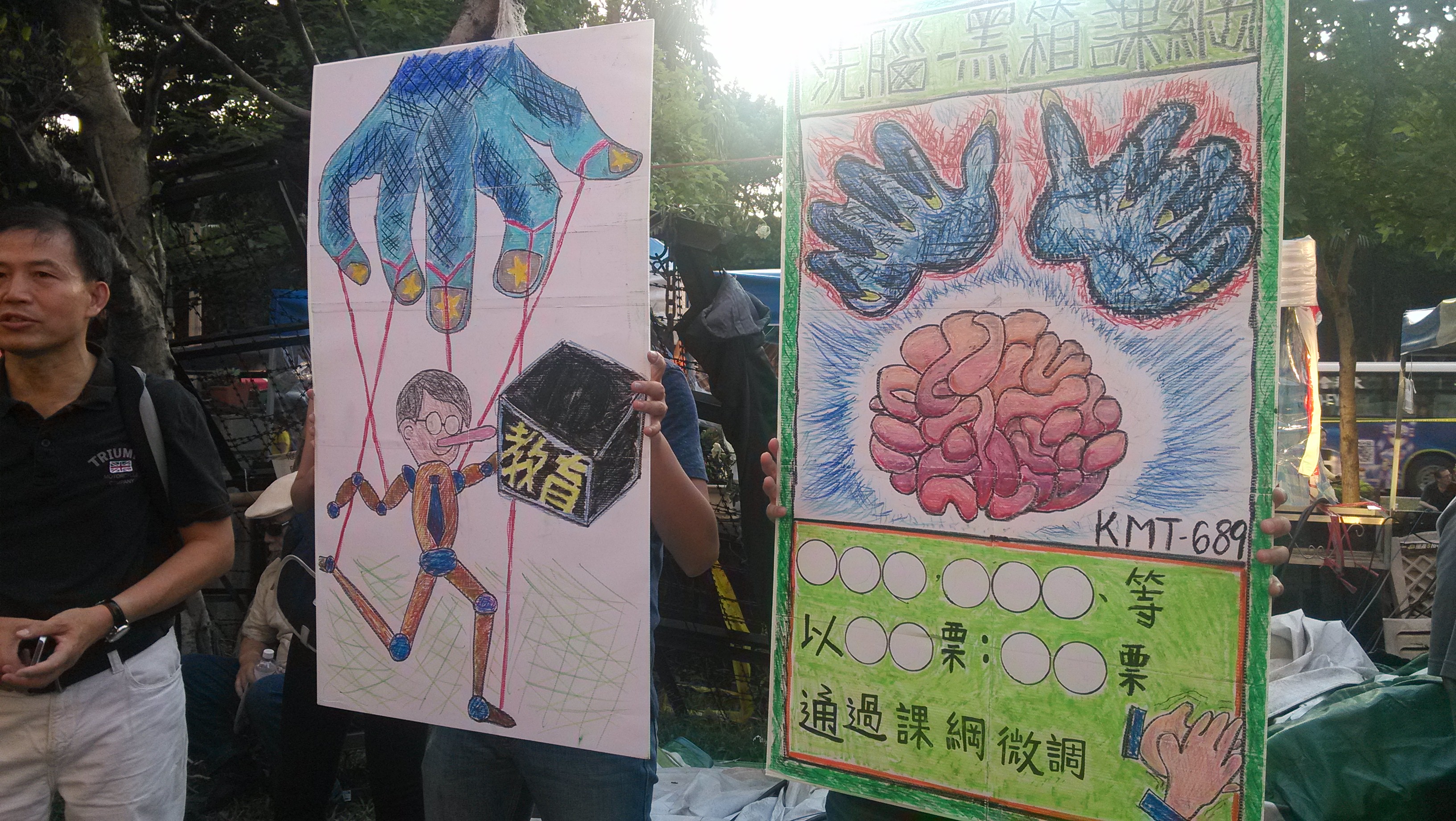 Poster at the Ministry of Education encampment. The poster on the left is a caricature of Minister of Education Wu Se-Hwa and a depiction of the so-called “black box.” Photo credit: Brian Hioe
Poster at the Ministry of Education encampment. The poster on the left is a caricature of Minister of Education Wu Se-Hwa and a depiction of the so-called “black box.” Photo credit: Brian Hioe
Given that Taiwan is largely only reported upon in relation to China, that the “black box” textbook issue is one put in place by the KMT may be a decisive factor in the lack of news coverage, given that the signing of the CSSTA trade agreement involved China as well. International media similarly tends to understand very little of the complexities of Taiwan’s incomplete democratic transition—and that the KMT is hardly one of two theoretically equal political powers but wields enormous power through its continued grip on some sectors of government, vast financial resources, and its party apparatus distributed through Taiwan. The critical point may be that international media would seem to largely efface the issue of the KMT and its history of authoritarian democracy in favor of the Taiwan-China angle in which Taiwanese politics solely occurs in relation to China. And here China is only indirectly involved, where the last year’s events of the Sunflower Movement directly had to do with China where the CSSTA trade agreement was an agreement to be signed with China.
Even if last year’s Sunflower Movement was also underreported upon, given Taiwan’s international obscurity, one is also surprised at the near total absence of attention by international media at present. In the year following the Sunflower Movement and Umbrella Movement and a year in which anxieties regarding Chinese territorial expansion have quite often been spotlighted in the news, one would expect at the very least a bit more coverage, even if only along the Taiwan-China or anti-China angle.
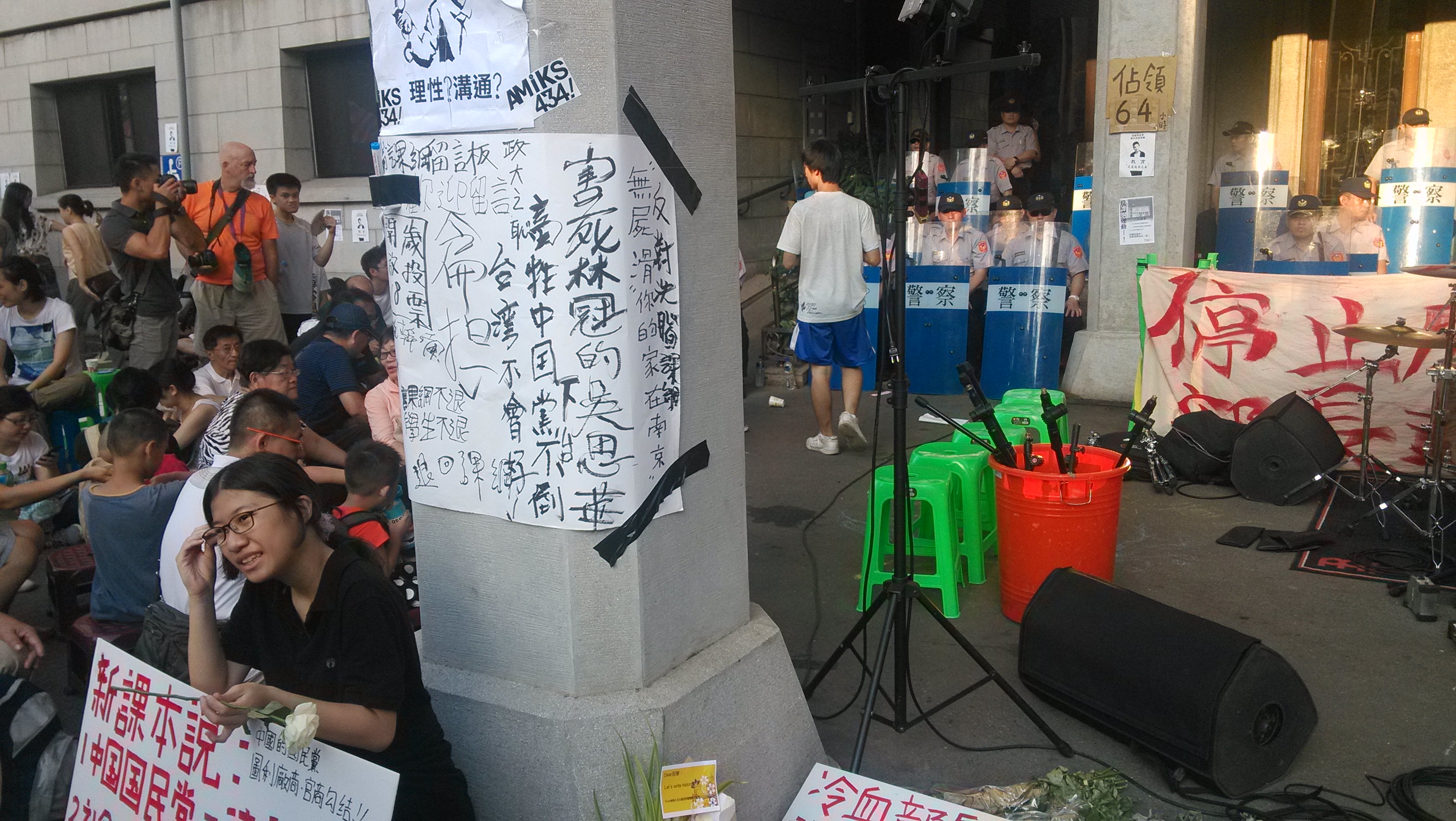 Riot police stationed outside the entrance to the Ministry of Education. Photo credit: Brian Hioe
Riot police stationed outside the entrance to the Ministry of Education. Photo credit: Brian Hioe
But within Taiwan itself we might also point towards the surprising lack of coverage from Taiwan commentators and journalists who write in the English language. It may be that focus at present for them is placed on the four months upcoming to 2016 presidential elections. Maybe this is what is different between the Sunflower Movement last year and the present.
A Second Sunflower Movement?
ACTUALLY IT IS that the current protests over textbook reforms are the largest set of protests since last year’s Sunflower Movement. But it is that the fundamental questions at stake are not incredibly different from last year. Current protests see the participation of much of the same actors as during last year’s Sunflower Movement, although decidedly not as large.
However, as it is true that nobody died during last year’s Sunflower Movement, the death of Lin Kuanhua marks a tragedy which does not compare to last year—yet one might note the much more muted reaction to present events. To begin with, numbers this year are hardly as high as last year. But although it is true that present events have drawn out participants of last year’s Sunflower Movement who have largely been inactive since then, it is also true that the textbook issue is far from all-encompassing of society as the Sunflower Movement was.
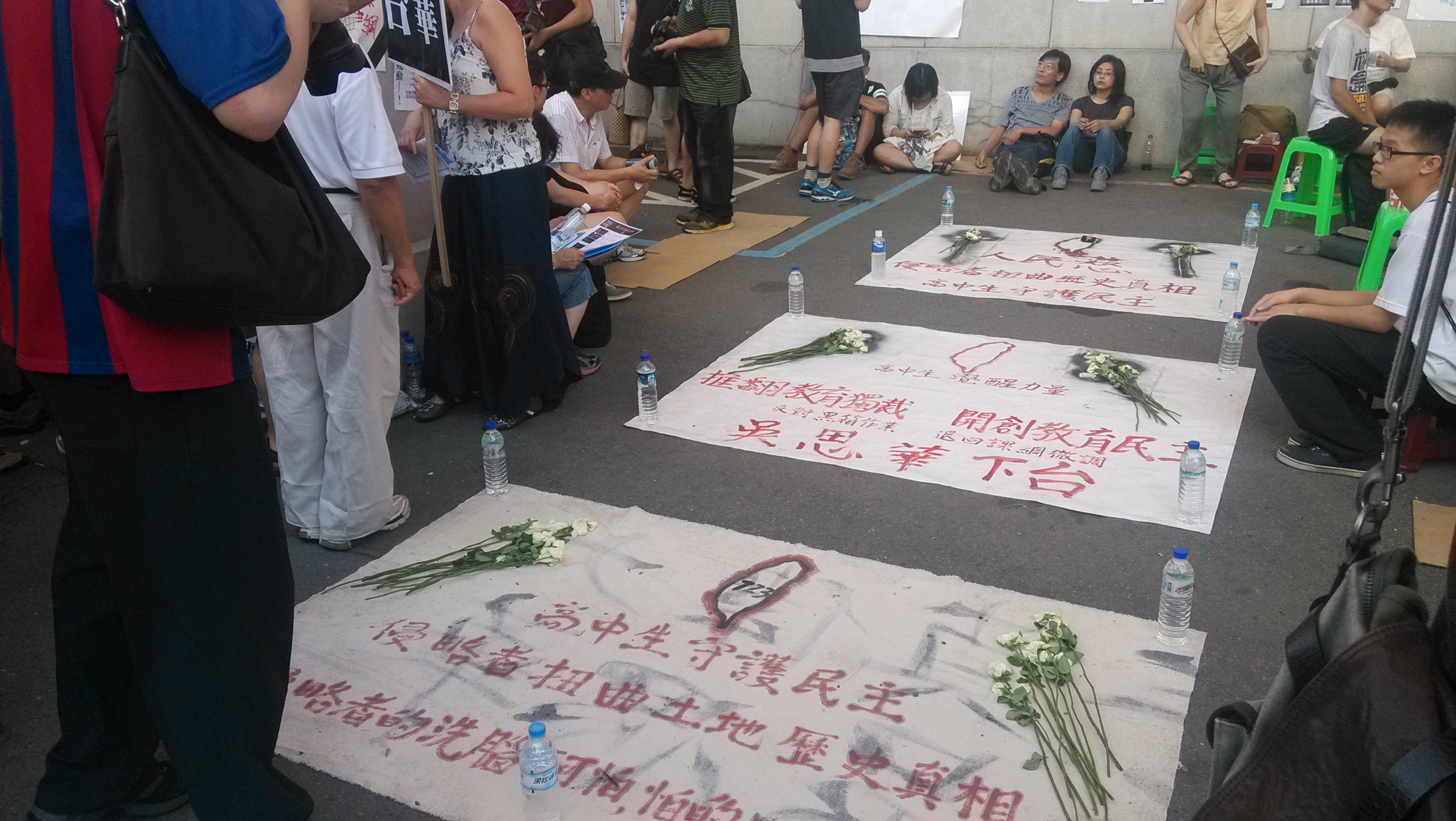 Flowers for Lin Kuanhua. Photo credit: Brian Hioe
Flowers for Lin Kuanhua. Photo credit: Brian Hioe
It may be that after last year, Taiwanese civil society does not have the capacity to field as large a social movement as last year. Namely, even one year after the Sunflower Movement, we can point to a certain exhaustion upon the part of civil society. Normally, such a movement maybe comes along once every ten years. There would seem to be little way to prepare for when another large-scale occupation movement breaks out scarcely a year later.
It is somewhat surprising that if the DPP was quick to jump on the Sunflower Movement bandwagon last year, by setting up an encampment off to the side of the Legislative Yuan almost right away, it seems less interested this time around. If international media is not particularly interested in reporting on present events because of a focus placed on upcoming elections, this may also be the case with the DPP. It would seem that the established political forces have much more geared towards next year’s election.
When politicians have participated in protests, it is largely the third parties closer to Taiwanese civil society, with speakers at the encampment as Freddy Lim of the New Power Party, expressions of support by Social Democratic Party politicians as Jennifer Lu and Miao Poya, or the participation of the Free Taiwan Party’s Tsay Ting-Kuei from the first night of the occupation. This, then, is continuation of last year given that these third parties emerged from civil society entering electoral politics in wake of the Sunflower Movement.
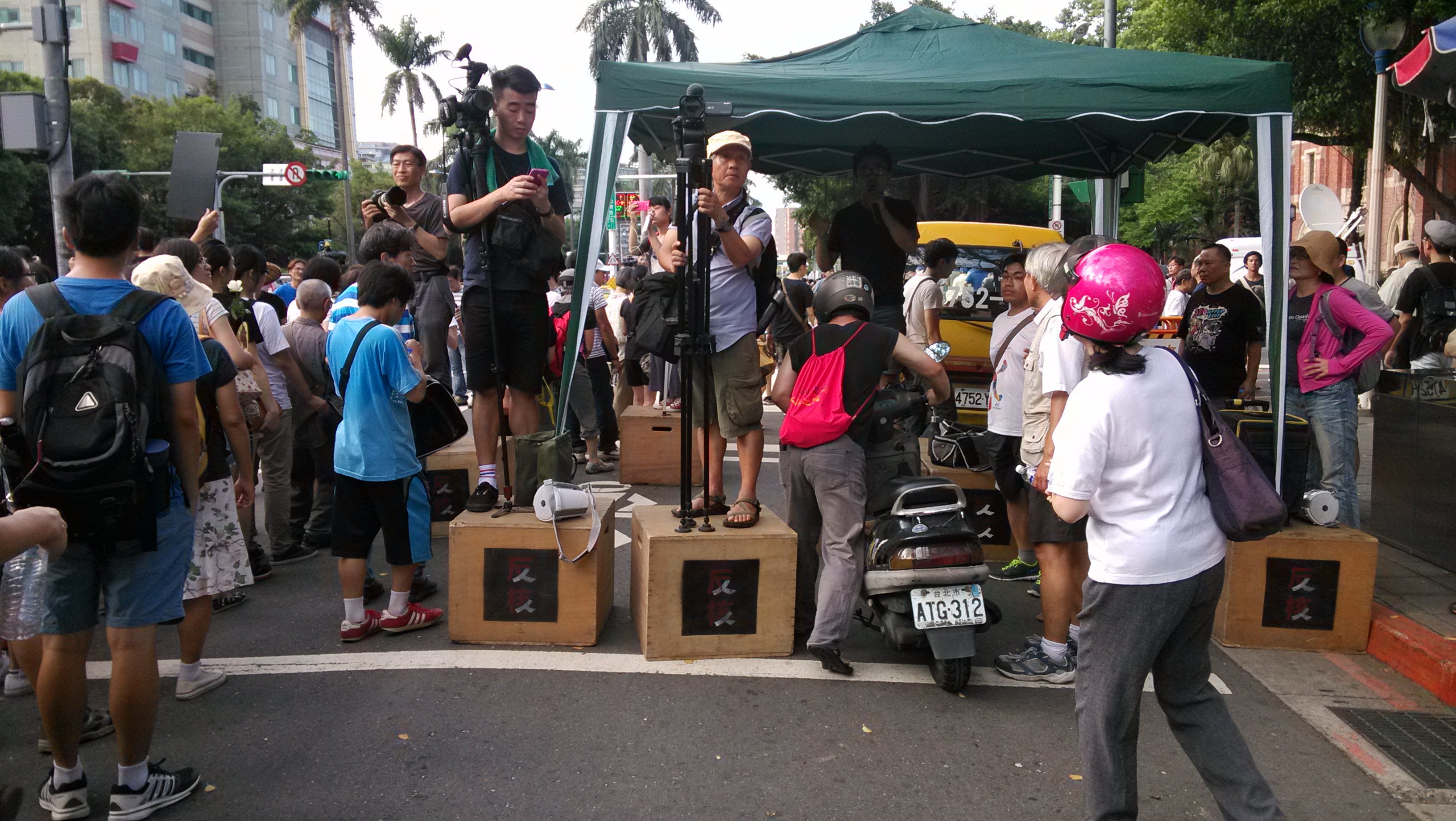 Demonstrators from the “5-6 Movement” anti-nuclear demonstration which was held every Friday at Freedom Plaza in Taipei for close to two years on August 2nd. Photo credit: Brian Hioe
Demonstrators from the “5-6 Movement” anti-nuclear demonstration which was held every Friday at Freedom Plaza in Taipei for close to two years on August 2nd. Photo credit: Brian Hioe
However, it is also a problem that the present movement lacks anything like last year’s attempts at international outreach. Present anti-textbook revision movement lacks anything like the translation group of the Sunflower Movement or the concerted attempts to explain Taiwan’s plight to the international world which took place during the Sunflower Movement. And although present protests have not been as large as last year’s Sunflower Movement, it proves surprising that there have been little in the way of coverage as with the Sunflower Movement—this despite the seizure of an entire ministry of government. How often does that happen across the world?
Deeper Issues at Hand?
WHAT WOULD BE truly heartbreaking about the death of Lin Kuanhua would be if the movement, in the end, still amounts to nothing. Namely, what is disturbing about the present movement is the way it has taken up the questions which were left unresolved at the end of last year’s Sunflower Movement—but that these questions went unfulfilled then and are unfulfilled now.
If it is that the spark behind this year’s anti-textbook revision movement and last year’s Sunflower Movement is largely the same issue this is because fiction by which Taiwan remains as the “Republic of China” persists and, in spite of everything, the power of the KMT government remains unbroken. It is still that in order to maintain its power, the KMT government attempts to maintain its claim that Taiwan is China and that, as such, the KMT is the rightful ruler of Taiwan. The textbook issue is one in which the KMT’s attempt to instill a China-centric curriculum is because the KMT has no other possibility of maintaining power except to inculcate Taiwan’s next generation with the belief that Taiwan is China.
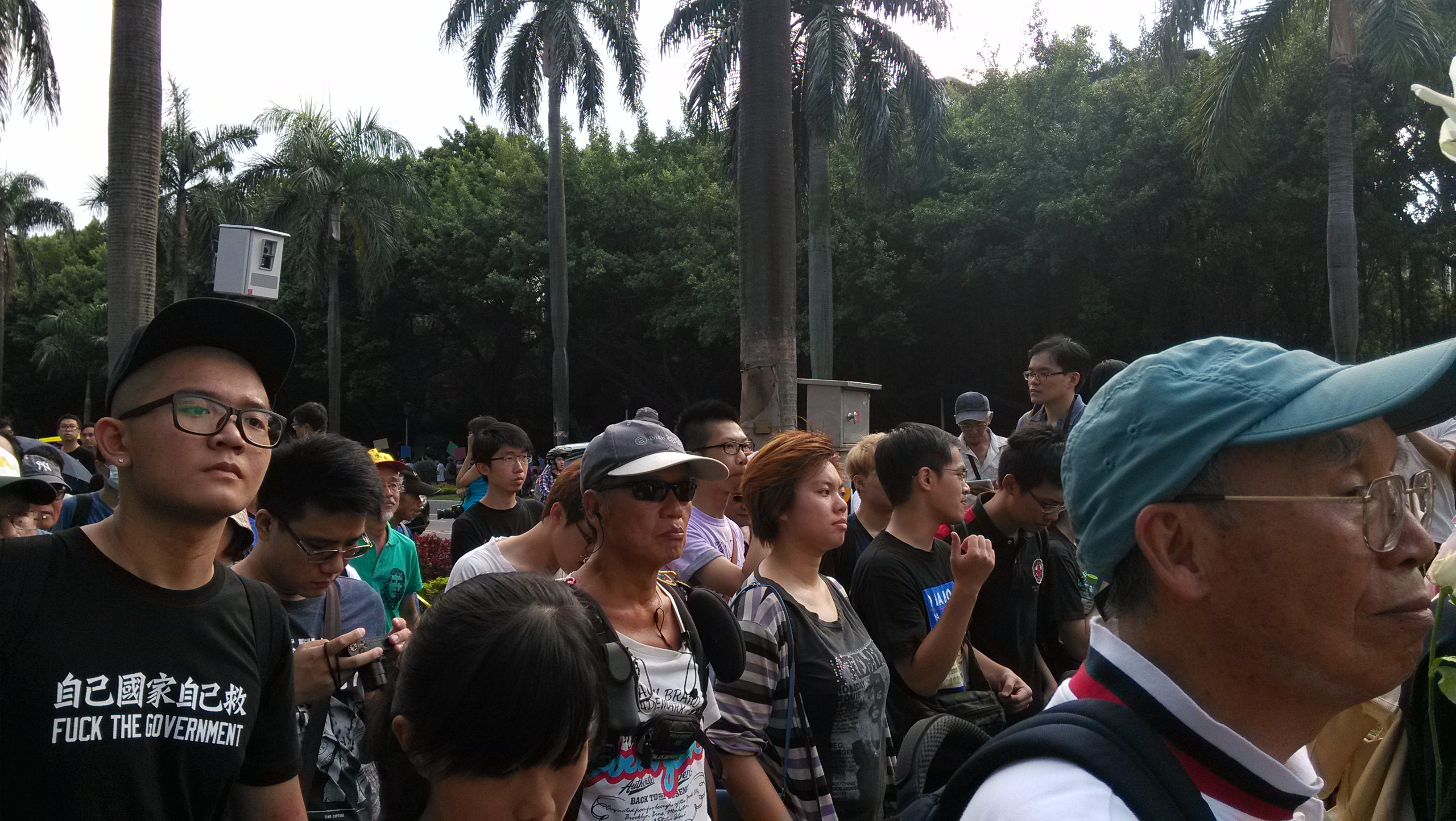 Demonstrators on August 2nd. Photo credit: Brian Hioe
Demonstrators on August 2nd. Photo credit: Brian Hioe
But if there is the possibility that the demands of student protestors will be met, it is because of the incomplete rule of law in Taiwan. One finds that in Taiwan, whether DPP or KMT, politicians are always scrambling to maintain public support. If an issue becomes unpopular enough, regardless of the processes of law, politicians back away from the act of actually enforcing that law. This may be case with the textbook revision, provided that backlash is strong enough that planned textbook changes are unpopular enough with the public at large.
Yet even if so, would that prove an adequate resolution to present events? What is at stake is larger problem. And if we are point to not only the recurrence of certain unresolved dilemmas as last year’s Sunflower Movement but certain points of regression in compared to last year, it is that the Ministry of Education is hardly as important as the Legislative Yuan or Executive Yuan and Minister of Education Wu Se-Hwa, who has been the target of popular dissatisfaction, is hardly as important a figure as Jiang Yi-Huah or Wang Jin-Pyng. If the issue is actually far larger than merely a matter of high school textbooks, there has been little discussion to date as to the larger issues, focus instead being upon the “black box textbooks” or blaming Wu Se-Hwa for Lin’s death.
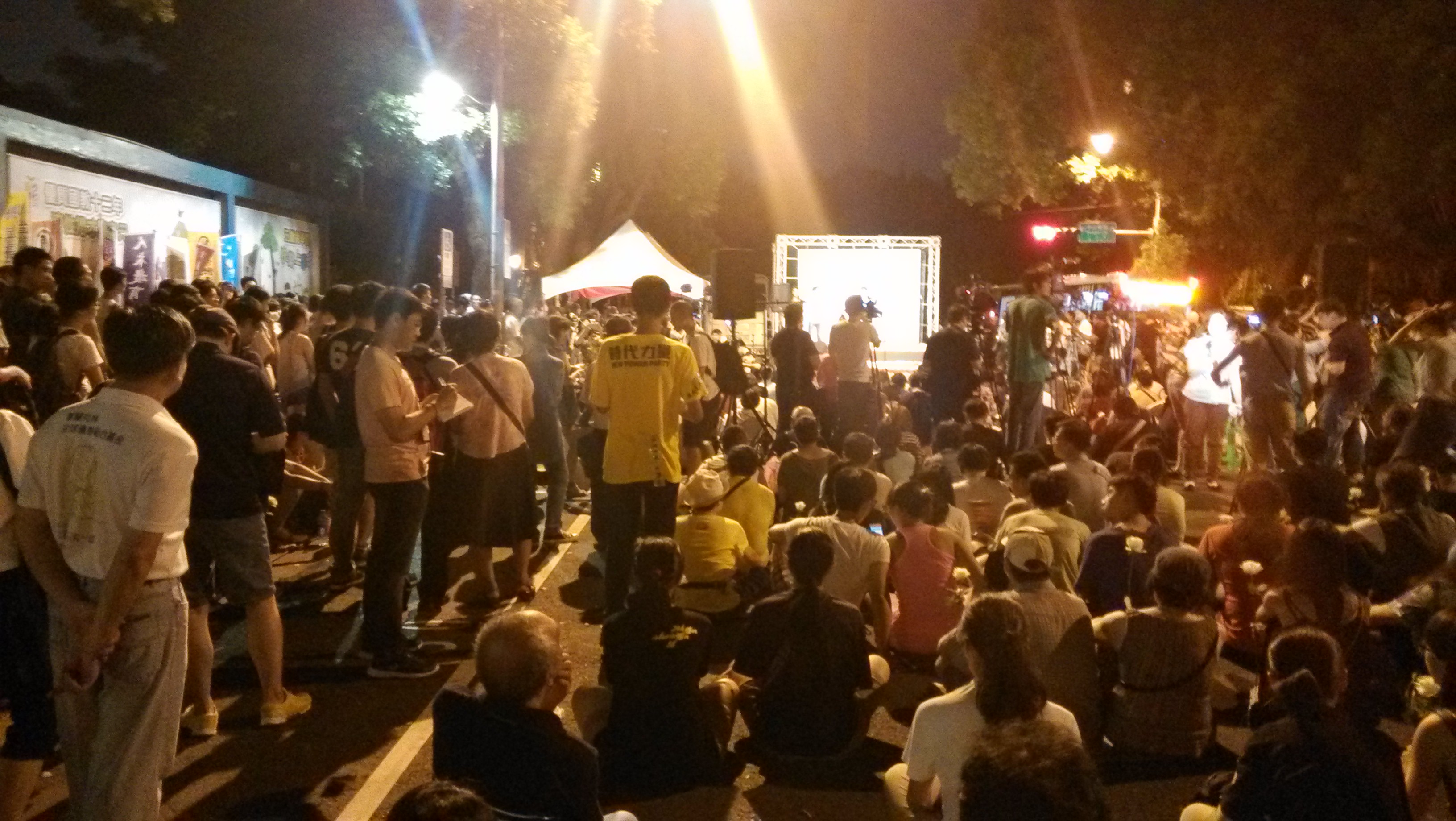 Rally held on the night of August 1st. Photo credit: Brian Hioe
Rally held on the night of August 1st. Photo credit: Brian Hioe
What is at stake is, of course, far more than simply just an issue of Taiwanese high school textbooks. A large part of what is at stake is the issue of Taiwanese democracy, where the KMT government has once again taken to pushing through undemocratic “black box” measures policies aimed at bringing Taiwan closer to China. However, there is too little talk of that this isn’t just a problem of a “black box,” but a systematic problem of Taiwanese lack of democracy whose ultimate origin is with the KMT.
What Now?
At present we find ourselves at the impasse where discussions were opened up between seven student representatives and Minister of Education Wu Se-Hwa this afternoon, but no decisions were made, no consensus was arrived at, and only discussion took place. In the end, discussions broke down as well, with students storming out of the negotiation on an individual basis. Students later held a press conference while sobbing. It did not appear that Wu Se-Hwa was, in fact, interested in negotiating in any way, rather the meeting served as an occasion for him to reiterate a defense of himself. So back to square one.
Despite the large-scale protest which took place on yesterday afternoon, it is probably true that numbers within the movement are dwindling. One was surprised, for example, how empty the premises were despite the performance of big name bands and well-known speakers at the concert which was held after the demonstration. There are not an extremely high number of demonstrators actually sleeping within the courtyard of the Ministry of Education.
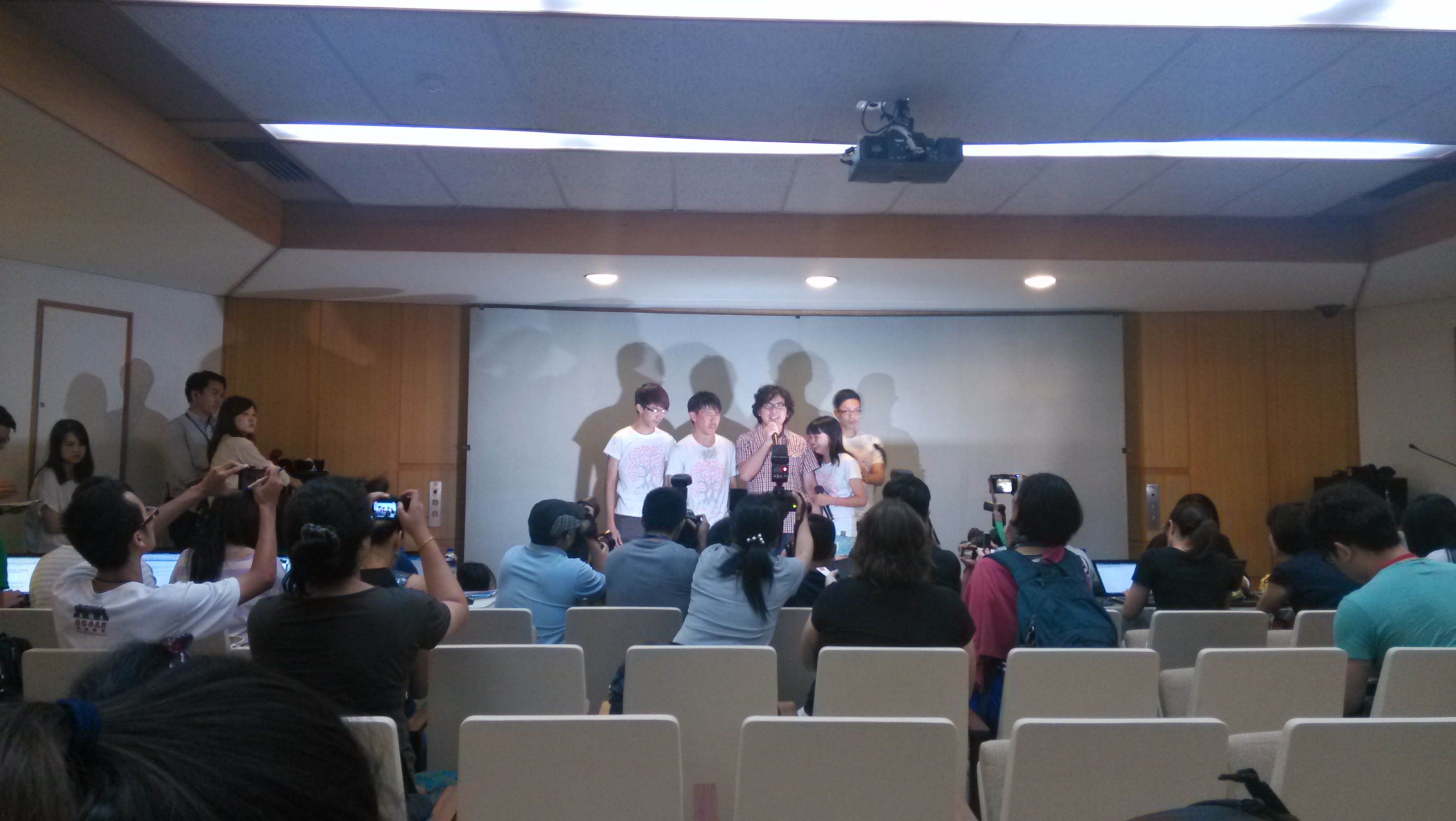 Students holding a press conference while sobbing earlier this afternoon. Photo credit: Brian Hioe
Students holding a press conference while sobbing earlier this afternoon. Photo credit: Brian Hioe
There is some worry at present that with the breakdown of negotiations, police will ultimately come in to sweep up those left. It is feared that now that the government has given the appearance of being willing to talk with students and negotiate them, now there is sufficient rationale to forcibly evict them. Yesterday, a water cannon truck was spotted behind the Ministry of Education hooked up to water supply, possibly in anticipation of future use. Although Taipei mayor Ko Wen-Je had promised to do his best to hold back police, provided that students did not go out of control. Ko’s control of the police is hardly absolute. And it was discovered that the water truck was registered to the central government, rather than Taipei. We will see what the night holds.
Taiwan’s young have stood up for the history that they stand for, against the history that the KMT government would have them believe. But the struggle is far from finished.










